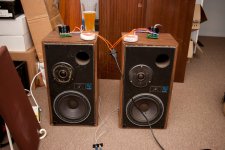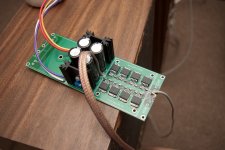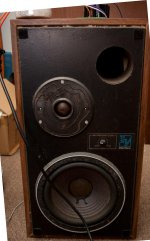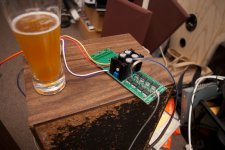I now have the amps all together and connected to my highest sensitivity speakers for testing. 😀




I forgot how beautiful these speakers sound 🙂 These little amps have no problems bringing the EVs up to decent levels.
I'm not the best at describing equipment but so far I can not fault these amps.
Time to sit back, have a glass of beer and listen to some good music
Thanks OPC for making the amps available! I am very happy with my pair.
Cheers,
Jake
I forgot how beautiful these speakers sound 🙂 These little amps have no problems bringing the EVs up to decent levels.
I'm not the best at describing equipment but so far I can not fault these amps.
Time to sit back, have a glass of beer and listen to some good music

Thanks OPC for making the amps available! I am very happy with my pair.
Cheers,
Jake
Attachments
How, when, where?
@Jacobthellamer, Looking very smart 😎
@opc, Owen how/where can I keep upto date on the commercial offering of this amp?
@Jacobthellamer, Looking very smart 😎
@opc, Owen how/where can I keep upto date on the commercial offering of this amp?
Last edited:
@Jacobthellamer, Looking very smart 😎
@opc, Owen how/where can I keep upto date on the commercial offering of this amp?
Same question... need to work out if I continue to wait, or start looking for something else.
They look ideal for my tweeters but need to settle on a direction soon. Even a rough ETA would suffice.
qusp and anyone who has built these up with the SumR tx from the GB, did you use an M5 bolt for mounting the transformer? I have some M5 bolts here but the thread will dig into the pcb hole for the mounting bolt.
I seem to remember that qusp said this is exactly what he did but my memory is a bit hazy right now.
I seem to remember that qusp said this is exactly what he did but my memory is a bit hazy right now.
Fellow lpuhp'ers did anyone end up using a heatsink other than the one on the BOM after all? I know Ed was looking into some aluminium bars for his at one point?
I've got a few bits of alu cut up and just in the sand/polish stage at the moment before bolting them all together. I hope in a week or so I'll have them in a state that I would be comfortable sharing photos of 🙂
I've been held up by a long string of excuses, the amps have been built and tested for months and I am now just dragging along with enclosure stuff and having to postpone building the speakers that these were going to power has taken some of the motivation away for me. It would be good to fire this thread up again though! 🙂
I've got a few bits of alu cut up and just in the sand/polish stage at the moment before bolting them all together. I hope in a week or so I'll have them in a state that I would be comfortable sharing photos of 🙂
I've been held up by a long string of excuses, the amps have been built and tested for months and I am now just dragging along with enclosure stuff and having to postpone building the speakers that these were going to power has taken some of the motivation away for me. It would be good to fire this thread up again though! 🙂
@Jacobthellamer, Looking very smart 😎
@opc, Owen how/where can I keep upto date on the commercial offering of this amp?
Same question... need to work out if I continue to wait, or start looking for something else.
They look ideal for my tweeters but need to settle on a direction soon. Even a rough ETA would suffice.
Same question again here...
An assembled version like the hypex modules (but with the powersupply included) with no box or external connectors would be great!
Or do I *really* need to buy another pair of nc400 modules just to power my 107db/1w/1m supertweeters above 10kHz? 😱
I've been held up by a long string of excuses, the amps have been built and tested for months and I am now just dragging along with enclosure stuff and having to postpone building the speakers that these were going to power has taken some of the motivation away for me. It would be good to fire this thread up again though! 🙂
I haven't built mine yet, and don't even have any good excuses 😱
I still need to get my transformers, will order this week, and hopefully finally start to assemble next week.
I would normally install the SM parts first, but for this build I plan to build and check out the PS section first, and then will build up the rest of the amp.
Current plans (always subject to change) are to used this as part of a fully balanced system for headphones.

Cans include K1000's (so I really do need the power, at least some of it) and maybe in the future a set of hifiman orthos.
Randy
Are they any lazy people who didn't get round to assembling their boards? I'm looking for another 4 channels. Come on - you know that you'll never get round to it!
Pm me please.
Pm me please.
LPUHP Amp Availability
Hi pos,
I've decided to take this in a bit of a different direction, and the results should be available by the end of February.
The new version has more power, more output devices, and will be fully differential input to output with the option of SE input with minimal performance degradation.
It's also a separate PSU and AMP (intended for external power supplies) since having the power transformer in close proximity to the amp resulted in some 60Hz harmonics still getting through.
The end product is quite a bit different from the humble beginnings of the LPUHP, but the performance and power will both be much improved.
I'm still tossing around the idea of offering it both as a kit (assembled boards) and a finished product, but it really depends on how many people are interested and whether or not a market for each type of person can co-exist.
Maravedis:
I have 4 fully built units that I'm willing to sell now that the new prototypes are in-house. Send me a PM if you're interested.
Cheers,
Owen
Hi pos,
I've decided to take this in a bit of a different direction, and the results should be available by the end of February.
The new version has more power, more output devices, and will be fully differential input to output with the option of SE input with minimal performance degradation.
It's also a separate PSU and AMP (intended for external power supplies) since having the power transformer in close proximity to the amp resulted in some 60Hz harmonics still getting through.
The end product is quite a bit different from the humble beginnings of the LPUHP, but the performance and power will both be much improved.
I'm still tossing around the idea of offering it both as a kit (assembled boards) and a finished product, but it really depends on how many people are interested and whether or not a market for each type of person can co-exist.
Maravedis:
I have 4 fully built units that I'm willing to sell now that the new prototypes are in-house. Send me a PM if you're interested.
Cheers,
Owen
Great!!
I think most of the readers on that board (not only the amp sections) would be more interested in assembled boards.
I know I am 😉
Hypex does exactly that: boards for both DIYers and manufacturers (with sometimes differents products for each group). They have managed to keep the two, and it seems it serves them well. I think the OEM market is much bigger than the DIYers for them, but the DIYers also have their interest in promoting the technologie...
I'm still tossing around the idea of offering it both as a kit (assembled boards) and a finished product, but it really depends on how many people are interested and whether or not a market for each type of person can co-exist.
I think most of the readers on that board (not only the amp sections) would be more interested in assembled boards.
I know I am 😉
Hypex does exactly that: boards for both DIYers and manufacturers (with sometimes differents products for each group). They have managed to keep the two, and it seems it serves them well. I think the OEM market is much bigger than the DIYers for them, but the DIYers also have their interest in promoting the technologie...
Definitely interested in some assembled boards. Don’t think I am up to doing a full board myself, but reckon I can easily do a bit of final piece assembly.
Assume a 230-240v 50Hz version is going to be an option?
Assume a 230-240v 50Hz version is going to be an option?
It's also a separate PSU and AMP (intended for external power supplies) since having the power transformer in close proximity to the amp resulted in some 60Hz harmonics still getting through.
Cheers,
Owen
Owen
As luck would have it, the last thing I need to order is the actual transformer.
Also, as more luck would have it, I can get a "standard transformer" for less than the torroid PC mount one that you specified.
I was thinking of mounting the transformer offboard, and wiring it in, figuring that would help keep the 60Hz away from the amp.
The only drawback is that the case needs to be a couple inches bigger, to make room for the transformers.
Do you think moving the transformers offboard would be beneficial?
Randy
Hi Randy,
I would fear that the increased magnetic field from a standard EI transformer would essentially null the benefits of moving it away from the amp, unless you moved it quite a ways away.
The specified transformer is a fully shielded toroidal type which has a very low magnetic field, but even still, it produces enough noise that it pokes up above the incredibly low noise floor of this amp. The peaks are still more than 20dB lower then the noise floor of a typical amp, but I still don't like them 🙂
If you do plan to use an EI core, then distance will be your best friend. get it as far as possible from the input end of the amp, and see how it goes. You could always mock it up with the transformer fly-wired in, then move it closer and closer until you can just hear its effects, and back then back it away a bit.
I use a 103dB 1W/1m midbass, and a 116dB 1W/1m compression driver to listen for detectable noise. I think people would be surprised at just how much you can hear from a driver with the sensitivity over 110dB. Of course, if you only plan to use lower sensitivity drivers, then the tolerance is much greater.
Cheers,
Owen
I would fear that the increased magnetic field from a standard EI transformer would essentially null the benefits of moving it away from the amp, unless you moved it quite a ways away.
The specified transformer is a fully shielded toroidal type which has a very low magnetic field, but even still, it produces enough noise that it pokes up above the incredibly low noise floor of this amp. The peaks are still more than 20dB lower then the noise floor of a typical amp, but I still don't like them 🙂
If you do plan to use an EI core, then distance will be your best friend. get it as far as possible from the input end of the amp, and see how it goes. You could always mock it up with the transformer fly-wired in, then move it closer and closer until you can just hear its effects, and back then back it away a bit.
I use a 103dB 1W/1m midbass, and a 116dB 1W/1m compression driver to listen for detectable noise. I think people would be surprised at just how much you can hear from a driver with the sensitivity over 110dB. Of course, if you only plan to use lower sensitivity drivers, then the tolerance is much greater.
Cheers,
Owen
I'm glad to hear you mention that you've tested with a compression driver Owen, my speaker project has recently changed to using these on a 108dB 1W/1m compression driver rather than the ring radiator I had in mind previously.
I am certain that I won't need the additional power of your new revision though!
Chris
I am certain that I won't need the additional power of your new revision though!
Chris
Hi Randy,
I would fear that the increased magnetic field from a standard EI transformer would essentially null the benefits of moving it away from the amp, unless you moved it quite a ways away.
The specified transformer is a fully shielded toroidal type which has a very low magnetic field, but even still, it produces enough noise that it pokes up above the incredibly low noise floor of this amp. The peaks are still more than 20dB lower then the noise floor of a typical amp, but I still don't like them 🙂
If you do plan to use an EI core, then distance will be your best friend. get it as far as possible from the input end of the amp, and see how it goes. You could always mock it up with the transformer fly-wired in, then move it closer and closer until you can just hear its effects, and back then back it away a bit.
I use a 103dB 1W/1m midbass, and a 116dB 1W/1m compression driver to listen for detectable noise. I think people would be surprised at just how much you can hear from a driver with the sensitivity over 110dB. Of course, if you only plan to use lower sensitivity drivers, then the tolerance is much greater.
Cheers,
Owen
Thanks for the answer.
Sounds like I would be better off using the transformer you specified, but then moving it offboard to add some distance.
I was not planning to use a chassis large enough to really move it away, but of course I could use a larger chassis so I can get more distance from the transformers.
BTW, my K1000's have a spec'ed sensitivity of 74 db spl/mw, which is why they need some power, but since they are strapped to your head you don't need much spl either.
Randy
I dont think you even need to worry about the noise with those headphones, in fact I dont think people with real ears have to worry about the 'noise' at all.
just use the suggested TX onboard, its one of the quietest amps in existence as is.
Owen has just had it as an open project at home for too long without putting them in cases, so he obviously couldnt help himself, being in a somewhat symbiotic relationship with his instrumentation 😉
just use the suggested TX onboard, its one of the quietest amps in existence as is.
Owen has just had it as an open project at home for too long without putting them in cases, so he obviously couldnt help himself, being in a somewhat symbiotic relationship with his instrumentation 😉
Last edited:
I would be very interested in a stereo pair PCB-only of the amp-board. I missed out on the 1st board and plan to not do that again.The new version has more power, more output devices, and will be fully differential input to output with the option of SE input with minimal performance degradation.
I'm still tossing around the idea of offering it both as a kit (assembled boards) and a finished product, but it really depends on how many people are interested and whether or not a market for each type of person can co-exist.
I would not be interested in a finished product or assembled PCB. (Where's the DIY in that?)
So if you decide to sell PCB-only's for the amp: "1 stereo pair please!"
Earlier you said;
That holds for the balanced-out too I presume. Can I safely guess that a stereo pair of the to be released product would require 80 LME48600's?You need 40 buffers for a proper bridge configuration to double both the current and the voltage
Last edited:
- Home
- Amplifiers
- Solid State
- The Wire - Low Power Ultra High Perfromance (LPUHP) 16W Power Amplifier



